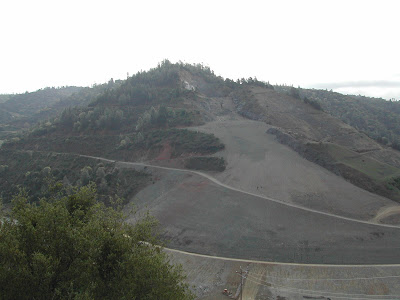We parked at the Auburn's Outlook Park just east of Railhead Park, behind the Gold Country Fairgrounds. The hike was all paved road with no vehicular traffic (Sunday). You start down an overgrown
Dump Road and turn left do Dale Drive, just go down. Did you follow the previous link, it will show you the dam sight from the map satellite.
Later this year the diversion tunnel will be closed up and the water will return to it's "original" path.
The first picture is looking up river, the American River.

Below is straight across. You can't see the pump house from this spot but it is straight down the mountain.

Looking down river you can see (click on picture it set a clear view) where the diversion tunnel comes out of the east back back into the river.

The massive scare were the western footing of the dam was started. We took a side road over to look down on the massive project. Part of the road we were walking on had slide down the mountain. The rocks that we stepped on were breaking beneath our feet. I can't imagine building anything substantial is such an geologically unstable area.

Fast Facts: The Auburn Dam
A report by the U.S. Bureau of Reclamation released Tuesday provides new numbers for the long-standing Auburn dam debate:
The new estimate on the cost for an Auburn dam project is between $6 billion and $9.6 billion.
Expenditures totaling $315 million that have already been made since the dam was first authorized by Congress in 1965 are not included in the estimate.
The report says environmental and other mitigation costs totaling $1.5 billion and new land costs of up to $2.3 billion are two major factors driving the increases in new cost estimates.
Total annual benefits would range from $76 million to $240 million, compared with the $60 million estimate in 1963 projections.
Much of the gain would come from hydroelectric power generation. Forty-two years ago, the estimated annual benefit was pegged at $6.5 million. The yearly range is now believed to be from $53 million to $113 million.
Source: U.S. Bureau of Reclamation




No comments:
Post a Comment